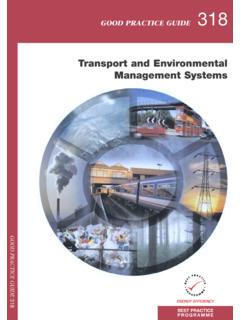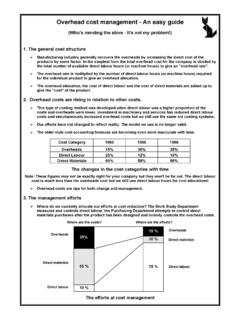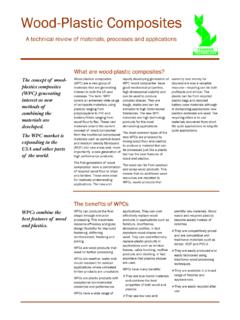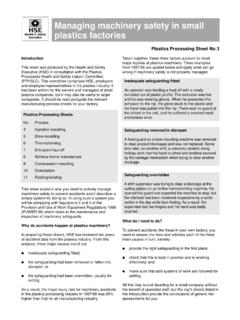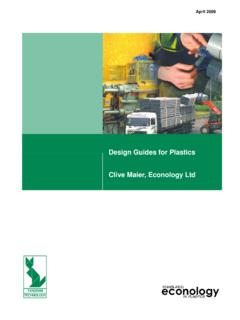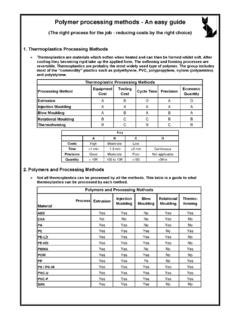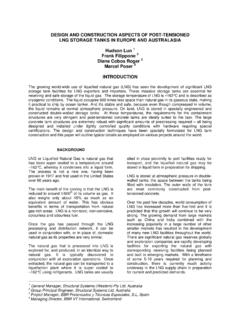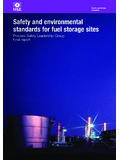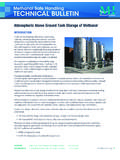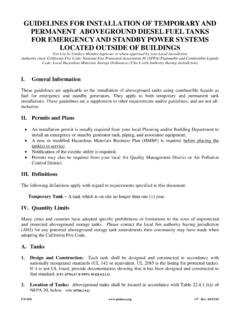Transcription of FUEL MANAGEMENT GUIDE - Tangram
1 FUELMANAGEMENTGUIDEGPG 307 SSeeccttiioonn 11 SSuuggggeesstteeddPPrrooggrraammmmeeooff WWoorrkkTHE GUIDEThis GUIDE contains information, advice and suggestions to improve the fuel performance of yourvehicle to other Energy Efficiency Best Practice Programme (EEBPP) publications will be found inthe suggested programme of work in Section 1 of the GUIDE . To obtain copies of EEBPP publications, and for further information on any energy-related issue,including transport, you can contact the Environment and Energy Helpline on 0800 585794. AllEEBPP publications are free of charge, as is the Helpline. You may also request Site Specific Advice from the Helpline. This involves allocation of a short period of free consultancy. Allocation of SiteSpecific Advice is at the discretion of the possible and appropriate, each section ends with a summary of action points. Examplesare either included in the text or in an appendix at the end of the the end of most sections, there is a simple checklist of key points covering the main GUIDE is available in electronic form from the Energy Efficiency Best Practice Programme website: time to time, updates to the GUIDE will be posted on the site for you to review and downloadas you wish.
2 Wherever possible, the sections are stand-alone, meaning that individual sections canbe downloaded is intended that further sections on specialist areas, such as aerodynamics, tyres, on-boardcomputers, alternative fuels, maintenance, and fuel -saving interventions, will be issued at a laterdate. These will cover the subjects in a more detailed, comprehensive and Energy Helpline on 0800 585794 This GUIDE was prepared by Fuelwise Ltd, The Willows, Bridgewater Road, Dundry, Bristol BS41 8 JPwith assistance from:Cheriton Technology MANAGEMENT LtdHuddersfield UniversityDavid WilcoxETSU for the EEBPP Crown copyright 2001 First published February 2001 IMPROVING MPG BY 5% COULD SAVE YOU AS MUCH AS 1,000 PER VEHICLEA ccording to an EEBPP survey carried out in 1998, the average large goods vehicle (LGV) in the UKtravels 130,000 km (80,000 miles) each year and uses diesel costing 20,000 (1998 figures).
3 Mostfleets that embark on fuel MANAGEMENT programmes show savings of at least 5%, meaning anaverage saving of 1,000 per vehicle per year. Recently, the price of fuel has risen faster than general inflation. If this continues, the value of fuelsavings will increase still that the impact of making a five per cent saving in costs is usually magnified in its effecton profit egIf current total costs = 500,000 then if fuel represents 30% of costs = 150,000and current profit (at say 5%)= 25,000then 5% savingin fuel costs= 7,500will increase profit by 30%to 32,500 Some operators will already have implemented a fuel improvement programme to varying on, you should assess where you are, and target the level of savings you will be trying IS THE GUIDE AIMED ATThe GUIDE is written for fleet operators with a variety of different levels of experience andknowledge.
4 If required, assistance in interpretation of the guidance is available from the Environment andEnergy Helpline (0800 585794).Using fuel more efficiently means: lower costs; improved profit margins; reduced emissions; improved environmental and Energy Helpline on 0800 585794 ACKNOWLEDGEMENTSF uelwise Ltd would like to thank the many organisations and individuals who have helped andcontributed to the fuel MANAGEMENT GUIDE Jones-Cheriton Technology MANAGEMENT Ltd-Continental Tyres Ltd-Huddersfield University-Institute of Road Transport Engineers-Leafield Engineering Ltd (VeMIS)-Logistics Purchasing Services Ltd (LPS)-Meggit Petroleum (TRISCAN)-Michelin Tyres Ltd-Robertson Research International Ltd-Rock Fuels-Shell UK Ltd-The Transport Engineer-UK PIA-VDO Kienzle Ltd-Volvo Truck and Bus Ltd-Warminster Systems LtdIn addition we would like to thank all the organisations that have allowed us to quote them in thecase studies/examples included in this and Energy Helpline on 0800 585794 SELF AUDITE nvironment and Energy Helpline on 0800 585794 SELF AUDITThe following Self Audit can be used to assess the status of fuel MANAGEMENT in your organisation,and together with the suggested programme of work in the next section, can help you to identify thepriorities for action and direct you to the right part of the AUDIT:Yes/No3 Does the MANAGEMENT of the organisation understand the importance of fuel MANAGEMENT :-What percentage of operating costs does it represent?
5 -What is the potential to reduce fuel costs?4 The fuel Champion and their action plan-Has a fuel Champion been appointed and do they have the necessary authority?-Is there a fuel MANAGEMENT plan of action or programme in place?7 How well are your fuel stocks managed? Do you review/have best practice in place for:-Ordering systems?-Receiving bulk stocks?-Controlling issues, stock movements and stock losses/gain?-Are maintenance contracts in place for bulk fuel tanks, tank desludging, fuel pump calibration?8 Does the organisation have good quality fuel performance information that is:-Accurate, timely and relevant?-Well communicated throughout the organisation?-Fed back to the drivers via notice boards, briefings etc?-Used by MANAGEMENT to help make decisions?-Used by maintenance together with service records to help identify poor driving habits and poorly performing vehicles?
6 SELF AUDITE nvironment and Energy Helpline on 0800 585794 SectionSELF AUDIT:Yes/No9 Are vehicles carefully specified to take into account:-Whole life costs?-Optimising vehicles to the requirements of the job?-Whether aerodynamic aids are appropriate?10 Does maintenance of the vehicles take into account their fuel performance?Are fuel performance figures available to those carrying out the maintenance of the vehicle?Is there a good balance between minimising maintenance costs and optimising fuel performance?Do maintenance monitor the vehicle for bad driving habits and report them back to the operational department? 11 Are the drivers in the organisation well motivated on fuel performance issues:Does selection of new recruits include checking their knowledge and understanding of fuel -efficient driving techniques?Does induction and general driver training include fuel efficient driving techniques?
7 Are driver disciplines well enforced, eg tank filling, daily checks, and have they been reviewed and updated to ensure they include fuel saving points?CONTENTSThe GUIDE consists of the following sections:Section1 Suggested programme of workSection2 The role of MANAGEMENT issuesAppendix 2 ACompany car driver league tableSection3 Financial aspects of fuel your current of the investment fuel and responsibilities the fuel action planSection5 Monitoring and of Monitoring and TargetingCONTENTSE nvironment and Energy Helpline on 0800 585794 Section6 Factors affecting fuel and and the effects of the fuel specification and low sulphur diesel and ultra ultra low sulphur recording systemsAppendix 7 AFuel stocks/use reconciliation procedureSection8 Data data analysis and the and bad key performance indicators (KPIs) and targetsAppendix 8 ASuggested driver daily work reportAppendix 8 BExamples of typical report formsAppendix 8 CEffectiveness Analysis (EA)
8 CONTENTSE nvironment and Energy Helpline on 0800 585794 Section9 Specifying the life a demonstrator and and tyresAppendix 9 AAerodynamic the priorities s vehicle injection Oil and lubricationSection11 The fuel -efficient and league the disciplines and vehicle Fit all vehicles with speed Fit on-board Encourage drivers to monitor their own performanceCONTENTSE nvironment and Energy Helpline on 0800 One person responsible for Tachograph Agency driversAppendix 11 ASustainabilityAppendix 11 BFuel-efficient driving: Drivers questionnaireAppendix 11 CExample checklists for drivers and othersAppendix 11 DCommunicationsAppendix 11 ETraining the trainersAppendix 1 fuel MANAGEMENT and conversion factors1 Introduction2 Some benchmark values3 Conversion factorsAppendix 2 fuel cards1 Introduction2 Options3 Card features4 Card costsAppendix 3On-board computers and telematics1 Introduction2 Some typical systems3 The basic components4 Input devices5 The on-board computer6 Communication devices7 Driver identification device8 Download mechanisms9 Communications10 Host computer11 Database and reportsCONTENTSE nvironment and Energy Helpline on 0800 585794 APPROACHE nvironment and Energy Helpline on 0800 5857941 SUGGESTED PROGRAMME OF WORKThe following is one approach to developing and implementing a practical fuel managementprogramme.
9 It is of course up to you whether you follow it or develop your own assistance and EEBPP publications can be obtained by ringing the Environment and EnergyHelpline on 0800 Material Energy EfficiencyBest Practice ProgrammeGaining MANAGEMENT Read Section 2 Role of ManagementFL98020 Attitudes to fuel efficiencycommitmentRead Section 3 Financial ImplicationsECG59 fuel consumption in freight Nominate/appoint the fuel Championhaulage fleetsGPG251 Maintaining the momentum*ECG76 Benchmarking vehicle utilisation (Key Performance Indicators)FEB20 Energy efficiency in road transportPreparing the fuel ChampionRead Section 4 The fuel ChampionGPG84 Managing and motivating staff Get the Team on boardRead Section 5 Monitoring and Targetingto save energy *Develop Action PlanRead Section 6 Factors affecting FuelGPG172 Marketing energy efficiency *ConsumptionGPG186 Developing an effective Find similar organisations to your own toenergy policy *network withGPG235 Managing people, managing Use Trade Organisations (FTA/RHA/SOE etc)
10 Energy *Identify the key people in your organisation GPG213 Successful project Get them on boardmanagement for energy efficiency *Start data Read Section 8 Data CollectionGPG112 Monitoring and Targeting in collection/analysisEstimate costs and savingslarge companies *FuelRead Section 7 FuelTalk to pump hardware and software suppliersVehiclesRead Section 9 Vehicle SpecificationCAD 63/CAD 129 AerodynamicsRead Section 10 Vehicle MaintenanceTalk to vehicle manufacturersDriversRead Section 11 DriverGPCS311 Energy savings through Talk to vehicle manufacturersimproved driver trainingTalk to driver training organisationsVideo: Save It - the Road to fuel EfficiencyCommunicateRead Section 11D CommunicationsGPG213 Successful project MANAGEMENT for energy efficiency *ImplementGPG213 Successful project MANAGEMENT for energy efficiency *ReviewConfirm costs and savingsGPG213 Successful project MANAGEMENT for energy efficiency *Note: All EEBPP publications are free.
